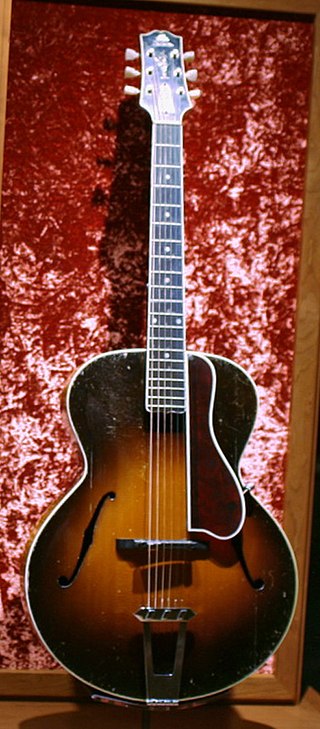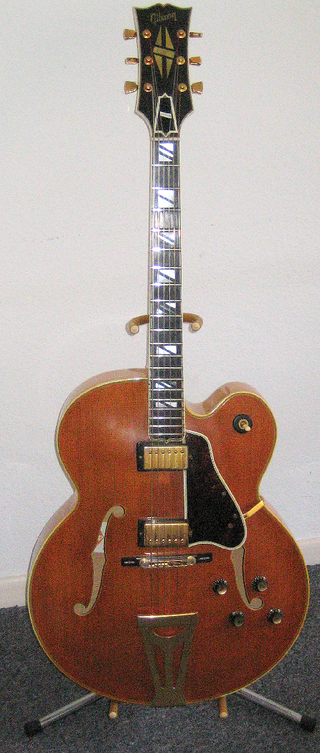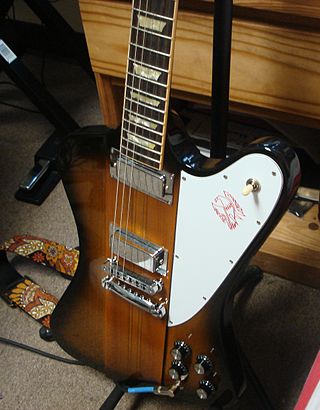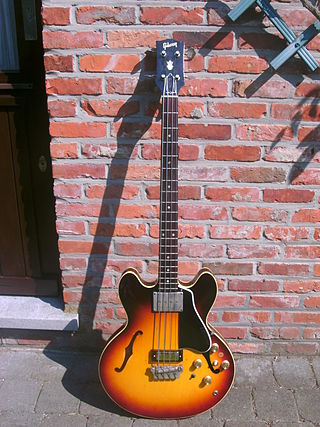
The Gibson L-5 is a hollow body guitar first produced in 1923 by the Gibson Guitar Corporation, then of Kalamazoo, Michigan. The first guitar to feature F-holes, the L-5 was designed under the direction of acoustical engineer and designer Lloyd Loar, and has been in production ever since. It was considered the premier guitar of the company during the big band era. It was originally offered as an acoustic instrument, with semi-acoustic models not made available until the 1940s.

The Gibson Les Paul is a solid body electric guitar that was first sold by the Gibson Guitar Corporation in 1952. The guitar was designed by factory manager John Huis and his team with input from and endorsement by guitarist Les Paul. Its typical design features a solid mahogany body with a carved maple top and a single cutaway, a mahogany set-in neck with a rosewood fretboard, two pickups with independent volume and tone controls, and a stoptail bridge, although variants exist.

The Gibson ES-335 is a semi-hollow body semi-acoustic guitar introduced by the Gibson Guitar Corporation as part of its ES series in 1958. It features a solid maple wood block running through the center of its body with upper bouts that are hollow and two violin-style f-holes cut into the top over the hollow chambers. Since its release, Gibson has released numerous variations of and other models based on the design of the ES-335.

An archtop guitar is a hollow acoustic or semi-acoustic guitar with a full body and a distinctive arched top, whose sound is particularly popular with jazz, blues, and rockabilly players.

The Gibson Firebird is a solid-body electric guitar manufactured by Gibson beginning in 1963.

The P-90 is a single coil electric guitar pickup produced by Gibson Guitar Corporation since 1946, as well as other vendors. Compared to other single coil designs, such as the ubiquitous Fender single coil, the bobbin for a P-90 is wider but shorter. The Fender style single coil is wound in a taller bobbin, but the wires are closer to the individual poles. This makes the P-90 produce a different type of tone, somewhat warmer with less edge and brightness. As with other single-coil pickups, the P-90 is subject to mains hum unless some form of hum cancellation is used.

The Gibson ES-125 is an archtop, hollow body electric guitar model that was produced by the Gibson Guitar Corporation.

The Gibson ES-175 (1949–2019) is a hollow body Jazz electric guitar manufactured by the Gibson Guitar Corporation. The ES-175 became one of Gibson's most popular guitar designs.

The Gibson ES-330 is a thinline hollow-body electric guitar model produced by the Gibson Guitar Corporation. It was first introduced in 1959 and the guitar had the same dimensions as the ES-335.
The Gibson Melody Maker is an electric guitar made by Gibson Guitar Corporation. It has had many body shape variations since its conception in 1959.

The Fender Coronado is a double-cutaway thin-line hollow-body electric guitar, announced in 1965. It is manufactured by Fender Musical Instruments Corporation. The aesthetic design embodied in the Coronado represents a departure from previous Fender instruments; the design remains an uncharacteristic piece of Fender history.

The Epiphone Casino is a thinline hollow body electric guitar manufactured by Epiphone, a branch of Gibson. The guitar debuted in 1961 and has been associated with such guitarists as Howlin' Wolf, George Harrison, John Lennon, Paul McCartney, Noel Gallagher, Keith Richards, Dave Davies, Brad Whitford, Shirley Manson, Paul Weller, The Edge, Josh Homme, Daniel Kessler, Brendon Urie, Gary Clark, Jr., Glenn Frey, John Illsley, and Peter Green.
The Gibson ES series of semi-acoustic guitars are manufactured by the Gibson Guitar Corporation.
The Epiphone Sheraton is a thinline semi-hollow body electric guitar. Though the Sheraton and all its variations were introduced under the ownership of the Gibson Guitar Corporation, Epiphone is the exclusive manufacturer.

The Epiphone Dot is a semi-hollow archtop electric guitar manufactured by Epiphone, a subsidiary of Gibson. It was introduced in 1997 as a more affordable version of the Gibson ES-335, at the high end of entry-level pricing. Reviews describe it as a robustly-constructed, versatile guitar with a smooth, powerful sound, suitable for jazz, blues and some rock styles, but lacking the high output required for heavy metal.

The Gibson ES-325 is a thinline hollowbody electric guitar model produced by the Gibson Guitar Corporation from 1972 to 1979.

The Gibson ES-137 is a semi-hollow-body guitar which was manufactured in Gibson's Custom Shop Memphis factory as a limited production run from 2002–2013. It was a relatively new design in Gibson's ES line which was not based on a vintage instrument, as many of Gibson's instruments are. The ES-137 is available in two models, Custom and Classic.

The Gibson ES-165 Herb Ellis is an Archtop guitar manufactured by the Gibson Guitar Corporation in Nashville Tennessee. By March 2013, it was no longer in production.

The Gibson EB-2 is an electric bass guitar model produced by the Gibson Guitar Corporation from 1958 to 1972, with a hiatus from 1962 to 1963. When production ceased in 1972, a total of 8017 instruments had been built, with 2102 of them being EB-2Ds. Willie Moseley, in Vintage Guitar, referred to the bass guitar as possibly "Gibson's biggest bass invention", although it was not a great commercial success, and the Epiphone Rivoli branded version of the model may have sold more copies than the Gibson branded one.

The Gibson ES-350T is an electric guitar model from Gibson Guitar Corporation, released in 1955. The ES-350T is a further development of the Gibson ES-350 model from 1948 and as such has a completely hollow body. The unique feature of the Gibson ES-350T at the time of its market introduction was the reduced width of the rims. As a result, the guitar has a thinner body compared to instruments with a resonance body that is of full thickness. The ES-350T, together with its sister models Gibson ES-225 TDN and Gibson Byrdland, was one of the first models of the thinline guitar type.

















